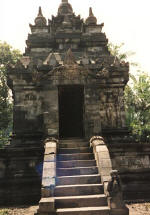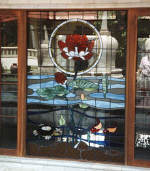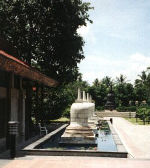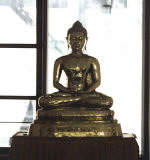Candi Medut Monastery
Central Java, Indonesia


A few months ago, I decided to visit the recently established Buddhist Monastery near Candi Mendut, some forty kilometres from the Central Javanese city of Yogyakarta. I was also particularly interested in seeing any changes to Candi Mendut – a Candi having a spiritual connection to Borobudur, the second largest Buddhist monument in the Southern Hemisphere. It is believed that the nearby Candi Pawon together with Mendut has a triangular complex, it’s apex pointing directly to Deer Park in India where Buddha first gave a sermon. Candi’s are in general, tombs of the dead, but Candi Mendut is a Candi of worship and dates back to the 9th Century. A huge ancient Banyan tree stands proudly sheltering the courtyard of the temple most of the day.


When we arrived there early in the morning, the first change I noticed was the increase in stalls selling tourist T-shirts, statues and the like. However, once entering the courtyard, the peaceful ambience seems to soothe the thoughts and body. I noticed the monastery set further back from the temple with little activity within its grounds.
The relief panels on Candi Mendut are the biggest compared to other Indonesian temples in Indonesia and portray Buddhist Goddesses. It is the interior of the Candi that is awesomely breathtaking. Three magnificent Buddhist statues stand tall side by side. A three metre high statue of a seated Sakyamuni Buddha has on one side, Bodhisattva Vajrapani, and the other, Bodhisattva Avalokitesvara – both being approximately 2½ metres high. Restoration of the Candi, by the Dutch, took place in the latter years of the 19th Century and was completed by 1904. In the inner chamber of the Candi, a ‘keeper’ watches over the statues and even offers to bring light into the dimly lit interior by using a large mirror reflecting the sunlight into the chamber allowing photographs to be taken. For such kindness a small donation should be offered.


The brightness of the sunlight dazzled my eyes as I left the chamber and walked down the steep steps. More cars had appeared in the car-park, the ubiquitous tourists scrambled towards the stalls in search of the perfect gift. Looking over to the monastery, I noticed that everybody seemed to ignore the place, preferring to head straight to the Candi. Unlike most monasteries in the world, the Candi Mendut Buddhist Monastery had no high wall around its grounds. Instead, two metre high freshly painted railings are the Monastery’s surrounds with a wide open railing entrance gate. We could freely walk around the grounds. The patches of lawn were beautifully manicured, and the paths swept clean. A half dozen bell shaped stupas rest peacefully in the centre of a square pond gracing the pathway leading to a series of steps upon which are various statues of Buddha in different positions. The long path from the entrance leads past a large prayer hall, its stained glass windows beautifully decorated with floral patterns. Inside the hall, a large gold Buddha statue sitting in the lotus position evokes a calm atmosphere.
Opposite the prayer hall an oblong shaped pond, its bottom decorated with floral tiles, the sunlight upon the water reflecting the patterns upon the surface of the water. In the pond, lily pads floated on the surface, dragonflies fluttered from one pad to the other. It was at this spot that a monk approached, placed his hands together, bowed his head and greeted us. We were informed that the monastery, although strictly for Buddhists, was open for all seeking the path to enlightenment. During the month of December, the monks held meditation classes at a minimal cost. The main stipulation the monk was quick to point out to my female friends was the monks’ quarters were deemed out-of-bounds to all visitors. For those partaking in the meditation classes, losmens and homestays nearby are cheap and comfortable.


The monk was kind in showing us more of the grounds with its beautiful rows of trees lining wide paths like avenues to Nirvana, the inner hall gracefully decorated with flowers, bowls of fruit were placed in precise positions in front of the gold statue – the offerings to Buddha. Incense sticks burned slowly in small gold vases, the ash falling onto squares of red velvet material. The calmness, the serenity, and the beauty gave one a feeling of total awareness – peacefulness. When we eventually walked to the entrance to leave, I turned for one last glance. A strange shiver ran up my spine and I knew that I would return there very soon.